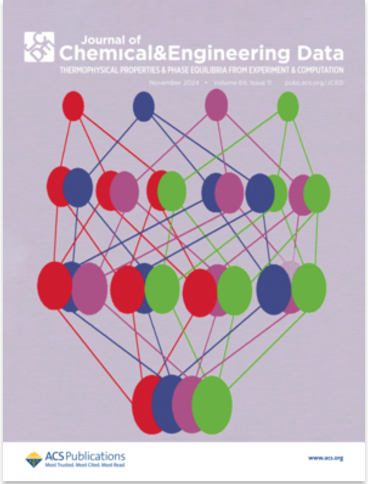使用疏水性深共晶溶剂形成的水胶辅助无表面活性剂微乳液的密度和动态粘度
IF 2
3区 工程技术
Q3 CHEMISTRY, MULTIDISCIPLINARY
引用次数: 0
摘要
在不含表面活性剂的微乳液(SFMEs)中,一种亲水物质有助于微乳液的形成。使用天然疏水性深共晶溶剂(HDES)作为油相具有环保优势。报告了以正癸酸(DA)为 HDES 的一种成分,以五种结构不同的闭环或开环萜类化合物[百里酚、l(-)-薄荷醇、芳樟醇、β-香茅醇和香叶醇]中的一种为另一种成分,以水为极性介质,按等摩尔比形成的氢拓扑乙醇胺(ETA)辅助 HDES 基 SFME 溶液的密度和动态粘度。在形成微乳液最佳的固定水胶浓度下,改变水的用量。在所有体系中,密度随着温度的升高呈线性下降。在水分量较高的情况下,SFME 的密度比预期的要高,这为水池的存在提供了理想的证据。由于与之相关的固有复杂性,动态粘度的温度依赖性更适合采用 Vogel-Fulcher-Tammann (VFT)公式,而不是阿伦尼乌斯方程。在高粘度(HDES/ETA)体系中加水后,粘度最初会降低,但在含水量较高时又会升高。这是因为形成的微乳液体积增大,阻碍了整体流动性。SFME 系统的密度和动态粘度揭示了这些有组织组合体的重要结构信息。本文章由计算机程序翻译,如有差异,请以英文原文为准。

Density and Dynamic Viscosity of Hydrotrope-Assisted Surfactant Free Microemulsions Formed with Hydrophobic Deep Eutectic Solvents
In surfactant-free microemulsions (SFMEs), a hydrotrope assists in microemulsion formation. Use of natural hydrophobic deep eutectic solvents (HDESs) as the oil phase imparts environmental benefits. Density and dynamic viscosity are reported for hydrotrope ethanolamine (ETA)-assisted HDES-based SFME solutions formed using n-decanoic acid (DA) as one constituent of the HDES and one of the five structurally different closed or open ring terpenoids [thymol, l(−)-menthol, linalool, β-citronellol, and geraniol] as the other constituent in equimolar ratio with water as the polar medium. The amount of water was varied at a fixed concentration of hydrotrope where the formation of the microemulsion was optimum. Density decreased linearly with an increase in temperature for all systems. At higher water fractions, the SFMEs exhibit higher density than that expected, ideally providing evidence for the presence of water pools. Because of the inherent complexity associated, the temperature dependence of the dynamic viscosity adheres better to the Vogel–Fulcher–Tammann (VFT) formulation instead of the Arrhenius equation. As water is added to a high-viscosity (HDES/ETA) system, viscosity initially decreases but increases at higher water contents. It is attributed to the increasing size of the microemulsions formed as they create a hindrance to the overall fluidity. The density and dynamic viscosities of the SFME systems reveal important structural information about these organized assemblies.
求助全文
通过发布文献求助,成功后即可免费获取论文全文。
去求助
来源期刊

Journal of Chemical & Engineering Data
工程技术-工程:化工
CiteScore
5.20
自引率
19.20%
发文量
324
审稿时长
2.2 months
期刊介绍:
The Journal of Chemical & Engineering Data is a monthly journal devoted to the publication of data obtained from both experiment and computation, which are viewed as complementary. It is the only American Chemical Society journal primarily concerned with articles containing data on the phase behavior and the physical, thermodynamic, and transport properties of well-defined materials, including complex mixtures of known compositions. While environmental and biological samples are of interest, their compositions must be known and reproducible. As a result, adsorption on natural product materials does not generally fit within the scope of Journal of Chemical & Engineering Data.
 求助内容:
求助内容: 应助结果提醒方式:
应助结果提醒方式:


